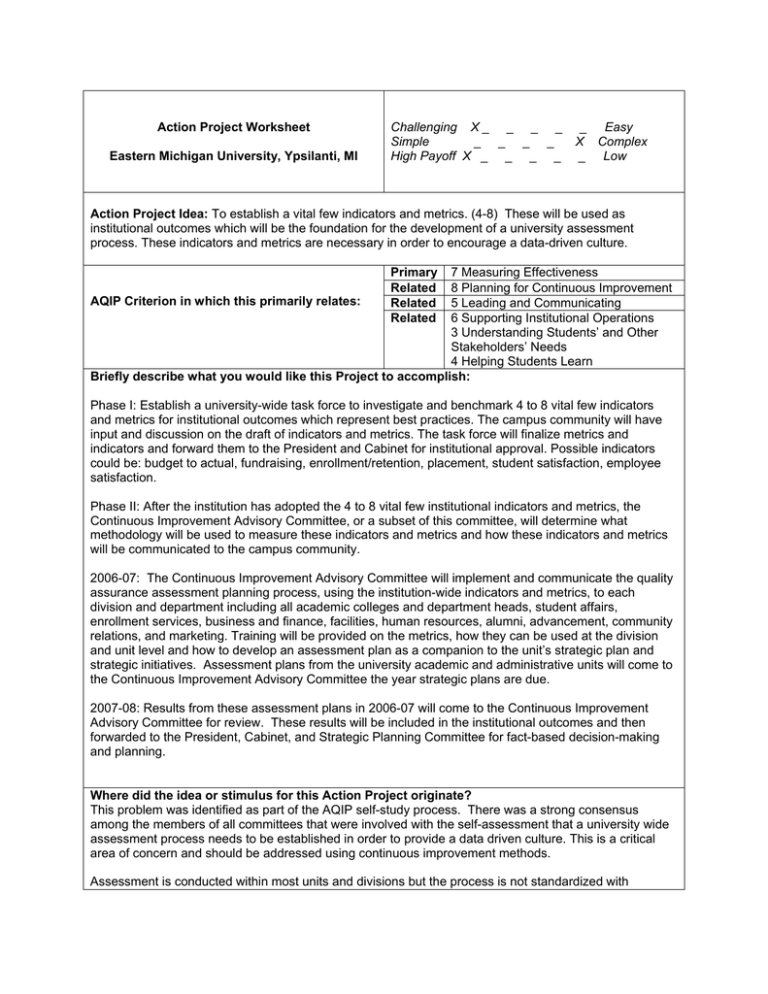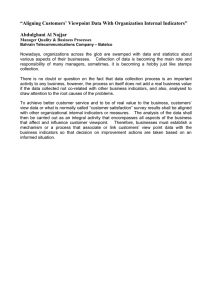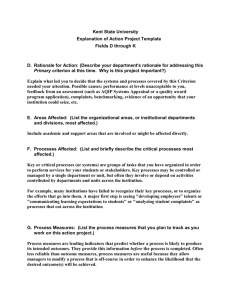Action Project Worksheet
advertisement

Action Project Worksheet Eastern Michigan University, Ypsilanti, MI Challenging X _ _ _ _ Simple _ _ _ _ High Payoff X _ _ _ _ _ Easy X Complex _ Low Action Project Idea: To establish a vital few indicators and metrics. (4-8) These will be used as institutional outcomes which will be the foundation for the development of a university assessment process. These indicators and metrics are necessary in order to encourage a data-driven culture. 7 Measuring Effectiveness 8 Planning for Continuous Improvement AQIP Criterion in which this primarily relates: 5 Leading and Communicating 6 Supporting Institutional Operations 3 Understanding Students’ and Other Stakeholders’ Needs 4 Helping Students Learn Briefly describe what you would like this Project to accomplish: Primary Related Related Related Phase I: Establish a university-wide task force to investigate and benchmark 4 to 8 vital few indicators and metrics for institutional outcomes which represent best practices. The campus community will have input and discussion on the draft of indicators and metrics. The task force will finalize metrics and indicators and forward them to the President and Cabinet for institutional approval. Possible indicators could be: budget to actual, fundraising, enrollment/retention, placement, student satisfaction, employee satisfaction. Phase II: After the institution has adopted the 4 to 8 vital few institutional indicators and metrics, the Continuous Improvement Advisory Committee, or a subset of this committee, will determine what methodology will be used to measure these indicators and metrics and how these indicators and metrics will be communicated to the campus community. 2006-07: The Continuous Improvement Advisory Committee will implement and communicate the quality assurance assessment planning process, using the institution-wide indicators and metrics, to each division and department including all academic colleges and department heads, student affairs, enrollment services, business and finance, facilities, human resources, alumni, advancement, community relations, and marketing. Training will be provided on the metrics, how they can be used at the division and unit level and how to develop an assessment plan as a companion to the unit’s strategic plan and strategic initiatives. Assessment plans from the university academic and administrative units will come to the Continuous Improvement Advisory Committee the year strategic plans are due. 2007-08: Results from these assessment plans in 2006-07 will come to the Continuous Improvement Advisory Committee for review. These results will be included in the institutional outcomes and then forwarded to the President, Cabinet, and Strategic Planning Committee for fact-based decision-making and planning. Where did the idea or stimulus for this Action Project originate? This problem was identified as part of the AQIP self-study process. There was a strong consensus among the members of all committees that were involved with the self-assessment that a university wide assessment process needs to be established in order to provide a data driven culture. This is a critical area of concern and should be addressed using continuous improvement methods. Assessment is conducted within most units and divisions but the process is not standardized with consistent methods and measures. This further complicates communication and the ability to integrate information into the university systems which leads to duplication of efforts and unreliable results. Currently, there is no way to connect the mission, vision, strategic directions, strategic goals, and strategic objectives with the strategic initiatives or action plans. Currently, there is no systematic assessment process for follow-up to determine if the initiative or action plan had the desired outcomes. Which specific needs of your students or other external stakeholders would be better met if you accomplished this Project? How? In order to meet student, internal and external stakeholders needs for accountability, EMU requires clear outcomes and metrics tied to the mission, goals and objectives. This institution has not developed a culture of consistent assessment for academic or administrative programs. EMU has not developed a comprehensive systematic assessment geared toward improving decision-making and continuous improvement for all aspects of the university. This project will facilitate effective systematic measurement at the institution and within departmental or unit levels. This assessment process will also provide continuous improvement opportunities for communications and institutional operations. These improvements will have direct impact on the student and stakeholders information needs. Methodology: 1. Investigate and benchmark indicators and metrics for institutional outcomes which represent best practices at other universities. Determine the desired institutional indicators, metrics and outcomes for academic and administrative functions at EMU. Some of these outcomes might include: Learner Success this area might include: fall to fall retention, course success, workforce or graduate school placement rates, graduation rates by degree by major, staff and faculty professional development; Program Review for all University Units which might include: academic and non-academic program review; Satisfaction might include: alumni, employers, students, faculty and staff, customers, community; Stewardship which might include: university budget to actual, department/program budget to actual, other revenues and expenses, facility requirements and usage, full time/part-time faculty to student credit hour and sections taught; Enrollment might include: university high school market penetration, fall-to-fall enrollment by program/major, instructional load analysis for F,W,S/S, class size over a five year period, available classes over a five year period, delivery method usage; Demographics might include: comparison of university and department/program faculty/staff/student populations by gender, ethnic origin, and degree. 2. Develop a systemic process for implementing and deploying an assessment system that will be compatible with the EMU culture, including outcomes that will be measured over time. Strategic as well as assessment plans will be incorporated in the university’s planning cycle. 3. Select and analyze specific action projects as well as strategic plans, to measure progress, performance and identify improvement opportunities based on desired indicators and outcomes. How would doing this Project allow you to better meet your employees’ needs? Which, specifically? Employees’ needs would be met by: 1) Improving the institutional and unit level’s ability to measure effectiveness of their programs by using institutional measures as well as the unit assessment measures. 2) Assisting in the planning for continuous improvement at all levels of the university. 3) Improving communications by identifying the desired indicators and metrics to be used to measure outcomes at EMU. 4) Providing a systematic deployed process to be used as a template for any division, department or program within the University to support institutional operations. 5) Measuring continuous improvement performance outcomes based on desired indicators and metrics. 6) Enhancing the understanding of our students’ and other stakeholders’ needs 7) Developing a culture of evidence How would accomplishing this Project change or affect your institution’s culture? A systemic process for implementing an assessment system across various departments and units will be compatible with the changed EMU culture. Outcomes that will be measured over time will close the strategic planning feed-back loop. EMU will be encouraging a culture of evidence and a data-driven decision making process. What leadership and employee enthusiasm and support is there for doing this Project now? There is campus consensus that a university-wide system of metrics needs to be developed that will allow the institution and department/units to use common indicators to achieve desired outcomes. There is also consensus that a system of feed-back is necessary that will eliminate duplication of effort and provide effective communications to all members of the campus community for continuous improvement. EXAMPLE: The PDF file below is an example of how this AQIP action project might look on the web. There are many examples and models on the web but this one is from Grand Rapids Community College (GRCC). The web page has drill down capabilities. For example, if you click on one of the buttons on the front page, the next screen you see is what indicators were used to measure the first summary indicator. Additional drill down web pages shows further details on that indicator. In Phase I, the major indicators will be identified by a cross university committee. They might revolve around the University Directions, the AQIP categories or EMU might select others indicators like GRCC. In Phase II, a university wide committee will identify what indicators roll into the vital few and what security levels will be required as the information becomes available. At some point, the dashboard will be made available to the campus community and AQIP evaluators. The dashboard concept will provide needed information for the AQIP portfolio. This AQIP action project supports these categories: Measuring Effectiveness, Planning for Continuous Improvements, Leading and Communicating, and Supporting Institutional Operations. Please click on the PDF Adobe to view the example from Grand Rapids Community College Grand Rapids Community College. This is a graphic presentation on the complete institutional assessment AQIP action project. Vital Few Metrics/ Indicators Identified by University Committee Team presentations to the campus community on indicators and assessment planning implications for each unit Academic and nonnon-academic units prepare strategic and assessment plans Continuous improvement committee recommends strategies for improvements to college/ departments or divisions/ departments assessment plans Academic and nonnon-academic units provide results to continuous improvement for dashboard updates .




